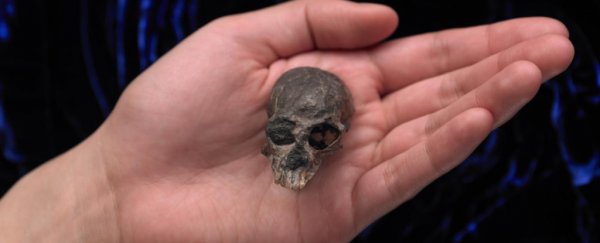How do you study the evolution of brains, without any ancient brains to study?
It's not a simple proposition, so it's no surprise that scientists are excited to have scanned the very well-preserved skull of a 20-million-year-old monkey species, Chilecebus carrascoensis.
"Human beings have exceptionally enlarged brains, but we know very little about how far back this key trait started to develop," said palaeontologist Xijun Ni from the Chinese Academy of Sciences.
"This is in part because of the scarcity of well-preserved fossil skulls of much more ancient relatives."
Around 36 million years ago, the ape ancestors catarrhines split from New World monkeys, the platyrrhines.
C. carrascoensis - a tiny animal that would weigh less than an original iPad - is a platyrrhine, and there have been precious few studies looking at their ancient brains, mostly because there are few intact skull fossils of platyrrhines to investigate.
This skull was first discovered in the 1990s, found high in the Andes mountains of Chile. Not only is this fossil a rare specimen, it could also be important for its place in the evolutionary tree.
"C. carrascoensis, from early Miocene volcaniclastic deposits of the central Andes, known from a single skull, is by many measures the best-preserved Neogene platyrrhine known," the researchers explain in the paper.
"Chilecebus was identified as one of the earliest diverging stem platyrrhines known, thereby making this taxon especially important for assessing ancestral cerebral features for the clade."
But a skull doesn't equal a brain, so the team had to use advanced CT scanning techniques of the tiny skull to create a 3D reconstruction of the brain it would have once contained.
You can see the reconstruction below:

"It's pretty remarkable," palaeontologist John Flynn from the American Museum of Natural History told Gizmodo.
"We were trying to convince ourselves it was anything but a primate, but it showed a bulbous area where the brain should be… The cleaning and subsequent CT scan analysis all reinforced that and the finding's significance."
The team then used the analysis to investigate specific aspects of this long-gone brain, such as the size of the olfactory bulb and the shape of the optical canal and optic nerve.
The relatively small olfactory bulb meant that these ancient monkeys probably had a weaker sense of smell. Despite that, this wasn't balanced out by better vision. The researchers think this might indicate that the evolution of the visual and olfactory systems wasn't as closely linked as we thought.
The opening of the optic nerve also suggests that the creature was diurnal - it slept during the night, and was active during the day.
"Comparisons of Chilecebus and other basal anthropoids indicate that the major brain subdivisions of these early anthropoids exhibit no consistent scaling pattern relative to the overall brain size," the team write.
"Many gross cerebral features appear to have transformed in a mosaic fashion and probably have originated in platyrrhine and catarrhine anthropoids independently."
The research has been published in Science Advances.
